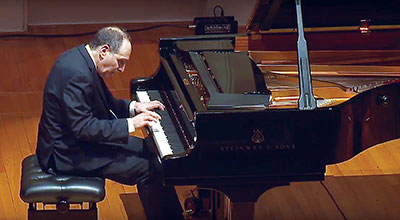Richard Kogan: ’S Wonderful Once Again
Abstract
The special lecture and recital by pianist-psychiatrist Richard Kogan, M.D., will mark the 100th anniversary of Gershwin’s “Rhapsody in Blue” and include other timeless classics from this “quintessential New Yorker.”

It’s encore time! After a six-year hiatus, psychiatrist and pianist Richard Kogan, M.D., will return to the APA Annual Meeting to offer one of his standing-room-only musical lectures and demonstrations. As the 2024 meeting will take place in New York, Kogan will discuss the life, music, and mental health of a quintessential New York composer: George Gershwin.
“Not only did he grow up in the city and spend most of his life there, but perhaps his most iconic piece is a perfect encapsulation of New York in the jazz age,” Kogan said. That iconic musical number is “Rhapsody in Blue,” which is celebrating its 100th birthday this year and will be one of the pieces Kogan will play and discuss.
Kogan is a clinical professor of psychiatry at Weill Cornell Medical College, artistic director of the Weill Cornell Music and Medicine Program, and co-director of the Weill Cornell Human Sexuality Program.
“Rhapsody in Blue” enthralled the audience upon its world premiere on February 12, 1924, at New York’s Aeolian Hall, and it quickly became a commercial success. It also led to a meteoric and surprising rise for the young Gershwin, who was only 25 at the time.
“Unlike many of the greats in the composer pantheon, Gershwin grew up in a home without music,” Kogan said. He was a typical New York tenement child, running around with friends and getting into trouble. “My perspective is that were he to grow up today, Gershwin might get a diagnosis of conduct disorder and possibly attention-deficit/hyperactivity disorder; he was impulsive and could not sit still in a classroom,” Kogan said.
His trajectory changed at age 10 when he stopped by a classmate’s violin recital and became captivated by the sounds he heard. His parents had recently bought a piano for Gershwin’s brother Ira, but George became the one to use it intently.
“It’s a pretty powerful story of music’s capacity to heal,” Kogan noted. “Most of his conduct and attention problems abated after he began studying music.” Gershwin dropped out of school at age 15 and started working as a song plugger (playing sheet music at music houses to promote and sell new songs); he also began working on his own compositions with the help of Ira, who provided lyrics. Gershwin produced several minor hits in musical theater before his breakthrough with “Rhapsody in Blue.”
“What may be relevant to our very divisive times is that Gershwin did not believe in rigid distinctions of musical genre,” Kogan said. “His popularity grew because he could unite genres that were considered distinct, like the classical and jazz elements of ‘Rhapsody.’ For him, it was just music.”
Another amazing trait of Gershwin that Kogan will discuss is Gershwin’s capability of extracting music from noise. “He would frequently open the windows of his house to use the city noise as stimulation. On a trip to Paris, for example, he became fascinated by the sound of Parisian taxi horns, which were different from New York horns.” Kogan said that Gershwin returned to the states with four of those taxi horns and used them in his 1928 composition “An American in Paris.”
Though he continued to be successful into the 1930s, some of his psychiatric issues resurfaced in the form of anxiety and depression, which led him to seek psychiatric treatment. “I think this phase of his career offers a fascinating look into how mental health impacts creativity,” Kogan said. For as Gershwin was receiving psychotherapy, he also began writing an opera based on DuBose and Dorothy Heyward’s play “Porgy,” a love story set amid an impoverished African American fishing community.
Though “Porgy and Bess” contained Gershwin’s signature style—seamlessly blending classical opera with folk music—it was also quite different from his previous works, Kogan noted. “It was an extraordinary act of imagination and empathy,” he said, resulting in a score full of poignancy, sorrow, and anguish.
Though many today consider “Porgy and Bess” to be the finest opera ever composed by an American, the show was a critical and commercial failure in its day. Kogan believes the negative reception contributed to a worsening of Gershwin’s depression, though his increasing mental and physical struggles (such as headaches and coordination problems) were also furthered by an undiagnosed brain tumor.
After collapsing at a friend’s house in July 1937, Gershwin was rushed to the hospital, and the tumor was discovered. After emergency surgery, he did not regain consciousness and died at just 38 years of age. Gershwin’s timeless classics live on, memorialized on stage, film, and marketing. Over the course of an evening, Kogan will share some of these classics, and the stories behind them, with APA. ■
“Rhapsody in Blue at 100: The Mind and Music of George Gershwin” will be presented Sunday, May 5, from noon to 1:30 p.m.



